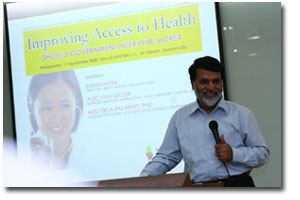Snakebites, Patents and Medicine Prices

Minimal Government (MG) Thinkers, Inc.
This 8-page report provides an overview of a symposium held to explore strategies for improving access to health in the Philippines. Jointly sponsored by the Program in Development Economics (PDE) of the University of the Philippines School of Economics (UPSE) and Minimal Government (MG) Thinkers, Inc., the September 2008 event reflected on several recent developments in the health sector: the passage by Philippine Congress of the "affordable medicines law" in June 2008, and the release of the World Health Organization's (WHO) August 2008 report "Closing the Gap in a Generation: Health Equity through Action on the Social Determinants of Health".
The first speaker, Mr. Alec van Gelder, Network Director, International Policy Network (IPN), London, United Kingdom (UK), addressed "Free trade and property rights: their role in increasing access to medicines and health care". He argued that a number of economically poor countries grappling with low access of the general population to quality medicines and health care are faced with insufficient health care infrastructures, more so than the issue of patents and intellectual property rights protection or confiscation.
Dr. Aleli de la Paz-Kraft, Assistant Professor, UPSE, Philippines, presented on the subject of improving access to medicines. She cited a number of figures to illustrate why medicine prices are an important factor in the overall health care situation in the country. For example, the Family Income and Expenditures Survey (FIES) 2003 report showed that, on average, 67% of all health care expenses by Filipinos were spent on buying medicines. In addition, she highlighted the fact that multinational pharmaceutical companies have priced certain medicines higher in the Philippines than in India and Pakistan, (the figures were generated by then President of a Philippine government corporation engaged in parallel importation of selected medicines, 2004 figures).
Mr. Barun Mitra, Director, Liberty Institute, New Delhi, India, focused on "Access to health care: the real barriers". He explained that certain necessary and prescription medicines are available for free to many economically poor people in India, but up to 70% of the Indian population still do not have access to quality health care. He stressed that certain health infrastructures - like hospitals and clinics, physicians and nurses, storage facilities for important medicines, roads and electricity for those clinics and medicine storage facilities, and so on - are more important compared to medicine prices and patents. As an example, he cited a WHO report finding that snakebites kill on average 50,000 people every year in India alone. Snake venom can be neutralised by certain medicines that are made available for free to many rural villages. The problem is that such medicines need storage at stable, low temperatures, but many villages do not have electricity, or have an unstable supply of electricity. Transportation costs for patients and their caretakers living in rural areas can be prohibitive. In this context, should governments intervene, strengthening those infrastructures first before intervening in the pricing of medicines, diagnoses and related health care services.
Open discussion focused on approaches to help bring down medicine prices, including a parallel importation scheme, and/or zero tariff and non-tariff barriers - for the entry of not only more and better quality medicines, but also for the establishment of innovator pharmaceutical companies.
The report's author, president of one of the symposium co-sponsors (MG Thinkers), explores the value of this educational gathering, "if only to remind people of the importance of assuming more personal, parental and community responsibilities in running their own lives, their households and their communities." That is, for those who understand health care as a personal responsibility rather than a governmental one, there can be less socialisation of health care, leading to lower prices stemming from more competition among innovator pharmaceutical companies, hospitals, clinics, and health and maintenance organisations (HMOs).
MG Thinkers website.
- Log in to post comments
